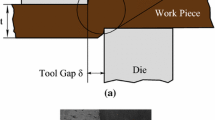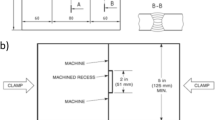Abstract
One of the most critical problems related to welding is the occurrence of Hydrogen-Induced Cracking (HIC), and despite all the efforts made to mitigate this defect, it remains present in the modern welding industry. Although the Gapped Bead-on-Plate (G-BOP) test is one of the most practical methods for assessing susceptibility to HIC, the use of a thick plate as the base metal (BM) restricts its application. Considering that many materials, such as the High-Strength-Low-Alloy (HSLA) steels, are difficult to find commercially in the required thickness, and also the fundamental need to appropriately represent the relationship between BM and electrode, da Silva, Fals and Trevisan developed a modified G-BOP test that uses a thinner sheet as the BM. Thus, the present paper aims to evaluate the ability of the Finite Element Method (FEM) to represent the thermomechanical aspects of the G-BOP test and to analyze its modified version using a numerical-experimental approach. In addition to consolidating the modified G-BOP test, the results corroborate the FEM as an important ally in HIC studies.















Similar content being viewed by others
References
Tsuboi K, Yatabe H, Yamada K (1996) Hydrogen induced cracking in high strength steel. Mater Sci Technol 12:400–404. https://doi.org/10.1179/026708396790165876
Chakraborty G, Rejeesh R, Albert SK (2016) Study on hydrogen assisted cracking susceptibility of HSLA steel by implant test. Def Technol 12:490–495. https://doi.org/10.1016/j.dt.2016.09.003
Maroef I, Olson DL, Eberhart M, Edwards GR (2013) Hydrogen trapping in ferritic steel weld metal. Inter Mater Rev 47:191–223. https://doi.org/10.1179/095066002225006548
Hu J, Yang J, Fang H et al (2006) Numerical simulation on temperature and stress fields of welding with weaving. Sci Technol Weld Joi 11:358–365. https://doi.org/10.1179/174329306X124189
Yurioka N, Suzuki H (1990) Hydrogen assisted cracking in C-Mn and low alloy steel weldments. Int Mater Rev 35:217–249. https://doi.org/10.1179/imr.1990.35.1.217
Graville BA, McParlan M (1974) Weld-metal cold cracking. Met Constr Br Weld J 6:62–63
da Silva JHF, Fals HC, Trevisan RE (2008) Proposal of a new G-BOP test to evaluate cracks in weld beads in thin sheets. J Fail Anal Prev 9:74–80. https://doi.org/10.1007/s11668-008-9199-5
Chakraborty G, Rejeesh R, Ramana OV, Albert SK (2019) Evaluation of hydrogen-assisted cracking susceptibility in modified 9cr-1mo steel welds. Weld World 64:115–122. https://doi.org/10.1007/s40194-019-00812-2
Attarha MJ, Sattari-Far I (2011) Study on welding temperature distribution in thin welded plate through experimental measurements and finite element simulation. J Mater Process Technol 211:688–694. https://doi.org/10.1016/j.jmatprotec.2010.12.003
Negi V, Chattopadhyaya S (2013) Critical assessment of temperature distribution in submerged arc welding process. Adv Mater Sci Eng. https://doi.org/10.1155/2013/543594
Chen Y, He Y, Chen H et al (2014) Effect of weave frequency and amplitude on temperature field in weaving welding process. Int J Adv Manuf Technol 75:803–813. https://doi.org/10.1007/s00170-014-6157-0
Pereira HAS, Rodrigues MC, Firmino JVLC (2019) Implementation of weave patterns by path parameterization in the simulation of welding processes by the finite element method. Int J Adv Manuf Technol 104:477–487. https://doi.org/10.1007/s00170-019-03861-5
Cañas J, Picón R, Pariís F et al (1996) A simplified numerical analysis of residual stresses in aluminum welded plates. Comput Struct 58:59–69. https://doi.org/10.1016/0045-7949(95)00112-T
Deng D, Murakawa H (2006) Numerical simulation of temperature field and residual stress in multi-pass welds in stainless steel pipe and comparison with experimental measurements. Comput Mater Sci 37:269–277. https://doi.org/10.1016/j.commatsci.2005.07.007
Deng D, Murakawa H (2008) Prediction of welding distortion and residual stress in a thin plate butt-welded joint. Comput Mater Sci 43:353–365. https://doi.org/10.1016/j.commatsci.2007.12.006
Deng D, Murakawa H (2008) FEM prediction of buckling distortion induced by welding in thin plate panel structures. Comput Mater Sci 43:591–607
Chang K, Lee C, Park KT et al (2010) Analysis of residual stress in stainless steel pipe weld subject to mechanical axial tension loading. Int J Steel Struct 4:411–418. https://doi.org/10.1007/BF03215848
Atkins G, Thiessen D, Nissley N et al (2002) Welding process effects in weldability testing of steel. Weld J 11:61–68
Teng TL, Chang PH, Tseng WC (2003) Effect of welding sequences on residual stresses. Comput Struct 81:273–286. https://doi.org/10.1016/S0045-7949(02)00447-9
Nóbrega JA et al (2016) Numerical evaluation of temperature field and residual stresses in an API 5L X80 steel welded joint using the finite element method. Met. https://doi.org/10.3390/met6020028
Goldak J, Chakravarti A, Bibby M (1984) A new finite element model for welding heat sources. Metall Trans B 15B:299–305
Kern DQ (1965) Process heat transfer. McGraw-Hill, New York
Budynas R, Nisbett J, Shigley J (2014) Shigley’s mechanical engineering design. McGraw-Hill, Chicago
IIW Sub-Commission IXJ (1988) Guide to the light microscope examination of ferritic steel weld metals. IIW Doc. IX-1533- 88
Acknowledgements
The Departments of Mechanical and Materials Engineering of the Universidade Federal da Paraíba (Brazil), with its many laboratories, provided all the structure needed for the production of the article.
Funding
This work is financially supported by CNPq (Brazil).
Author information
Authors and Affiliations
Corresponding author
Ethics declarations
Conflict of interest
The authors declare that they have no conflict of interest.
Additional information
Author contribution
Saulo M.A. Duarte is the main author, having contributed to the experimental analysis and writing of the article. Heitor A.S. Pereira contributed to the simulations and editing the article. José H.F. da Silva and Kelly C. Gomes served as supervisors.
Publisher’s note
Springer Nature remains neutral with regard to jurisdictional claims in published maps and institutional affiliations.
Rights and permissions
About this article
Cite this article
Duarte, S.M.A., Pereira, H.A.d.S., Gomes, K.C. et al. Numerical-experimental analysis of a modified G-BOP test to evaluate cracks in weld beads in thin sheets. Int J Adv Manuf Technol 118, 2559–2569 (2022). https://doi.org/10.1007/s00170-021-08121-z
Received:
Accepted:
Published:
Issue Date:
DOI: https://doi.org/10.1007/s00170-021-08121-z




